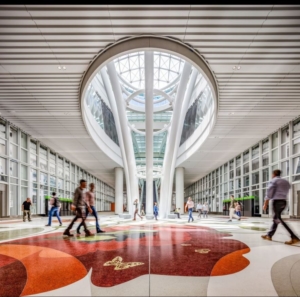
An abundance of funding has been allocated to public transit authorities … and more funding is on the way courtesy of the Bipartisan Infrastructure Law. Interestingly, a trend has emerged that indicates a common practice throughout the country. Public officials at the local levels of government are designing transit projects to spur other types of development around bus and rail routes. Because of that, contractors who monitor transit opportunities are likely to find myriad additional upcoming opportunities surrounding planned public transit projects.
City officials in Huntsville. Alabama. will upgrade the public transit system as part of a downtown revitalization effort. A new transit transfer station will be constructed at the intersection of two heavily trafficked streets in the heart of the city. Planning is underway, and then demolition will be required as part of site preparation. Construction is slated for early 2023. The project will be funded by a $12.5 million Federal Transit Administration grant that will be consolidated with another $15.6 million from the city’s budget.
 The Memphis Urban Area Metropolitan Planning Organization has assigned a project cost of $77.6 million to a public transportation project that will be designed to develop smart city technology and green infrastructure as well as upgrade a transit system. The project is expected to spur development and economic stimulus along the route of a new bus rapid transit (BRT) system. The BRT will provide enhanced safety and more access locations throughout the city’s targeted equity zones.
The Memphis Urban Area Metropolitan Planning Organization has assigned a project cost of $77.6 million to a public transportation project that will be designed to develop smart city technology and green infrastructure as well as upgrade a transit system. The project is expected to spur development and economic stimulus along the route of a new bus rapid transit (BRT) system. The BRT will provide enhanced safety and more access locations throughout the city’s targeted equity zones.
Members of Cleveland, Ohio’s City Planning Commission recently approved a large project that will focus on transit-oriented development. The project’s objective is to provide dedicated bus lanes, improved traffic signals along the route and make the West Side neighborhood more accessible. A project cost between $40 million to $60 million has been assigned. Design work will be extensive, and solicitations will be released for construction after it is completed.
Washington state officials will launch transit projects intended to generate new economic activity in the North Snohomish County Region. The local transit authority, Community Transit, will build a new BRT line to transverse several underserved communities and tribal villages. The new transportation services will create more access and facilitate the ease of traveling to other regions of the state. Though transit officials have not released any anticipated costs for the project, a recent, similar project had a cost of $81 million.
In Nevada, a series of transit projects are part of the Regional Transportation Commission’s (RTC) goal of developing the southern part of the state into “an equitable, enjoyable, efficient, and creative community.” The RTC plans to develop a seamless multimodal transportation network to facilitate safe and efficient access to several of the most popular destinations in Las Vegas. A $5.3 million federal grant will be used to develop autonomous-vehicle shuttle service between a downtown central transit center and the city’s medical district. Another project includes construction of a BRT system that will connect downtown and the medical district to the University of Nevada, Las Vegas campus.
Montgomery County officials in Maryland have made transit-oriented development a high priority. The county’s budget will include large allocations to expand BRT lines into neighborhoods identified as Equity Emphasis Areas. The upcoming projects will advance the county’s high-capacity bus services, improve safety, and expand access to previously congested routes. The $87 million Veirs Mill Road segment of the project is but one part of the overall plan. Supporting studies and feasibility planning will continue with a budget of $33.4 million.
The city of Atlanta, which recently invested in an $800 million walking trail network to stimulate and leverage $4.1 billion in new development, is looking for equivalent results with another project. The Metropolitan Atlanta Rapid Transit Authority (MARTA) will soon launch a $300 million project to improve all 38 stations. The MARTA project will include numerous individual projects, but notable components of it are beginning to take shape.
The Santa Clara Valley Transportation Authority (VTA) is entering the second phase of its project to extend its Bay Area Rapid Transit (BART) system from San Jose to Santa Clara. The project will generate new economic activity across Santa Clara County. The budget includes $768 million in allocations from the California Transportation Commission plus over $200 million in federal funding. VTA is expected to request proposals before the end of 2022 for four new stations included in the extension. Another component of the project, which will enter construction in 2023, is designed to be integrated with surrounding mixed-use development which will boost the regional economy.
As regional public officials and economic development leaders continue to recognize the advantages of large transit-oriented development projects, and funding is readily available, there will thousands of contracting opportunities available to companies throughout the country.
